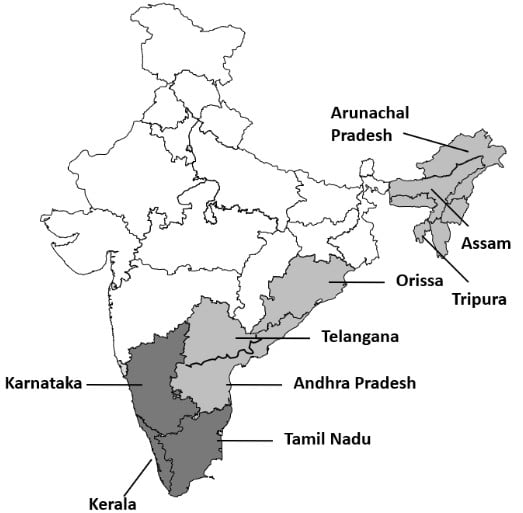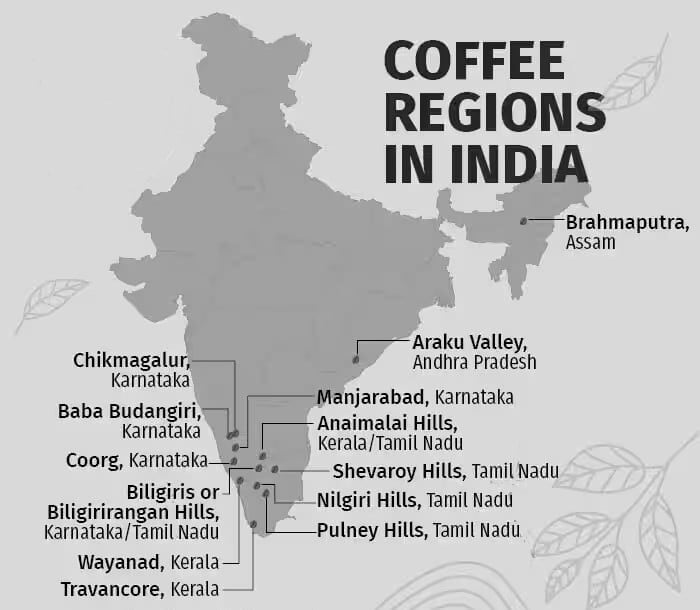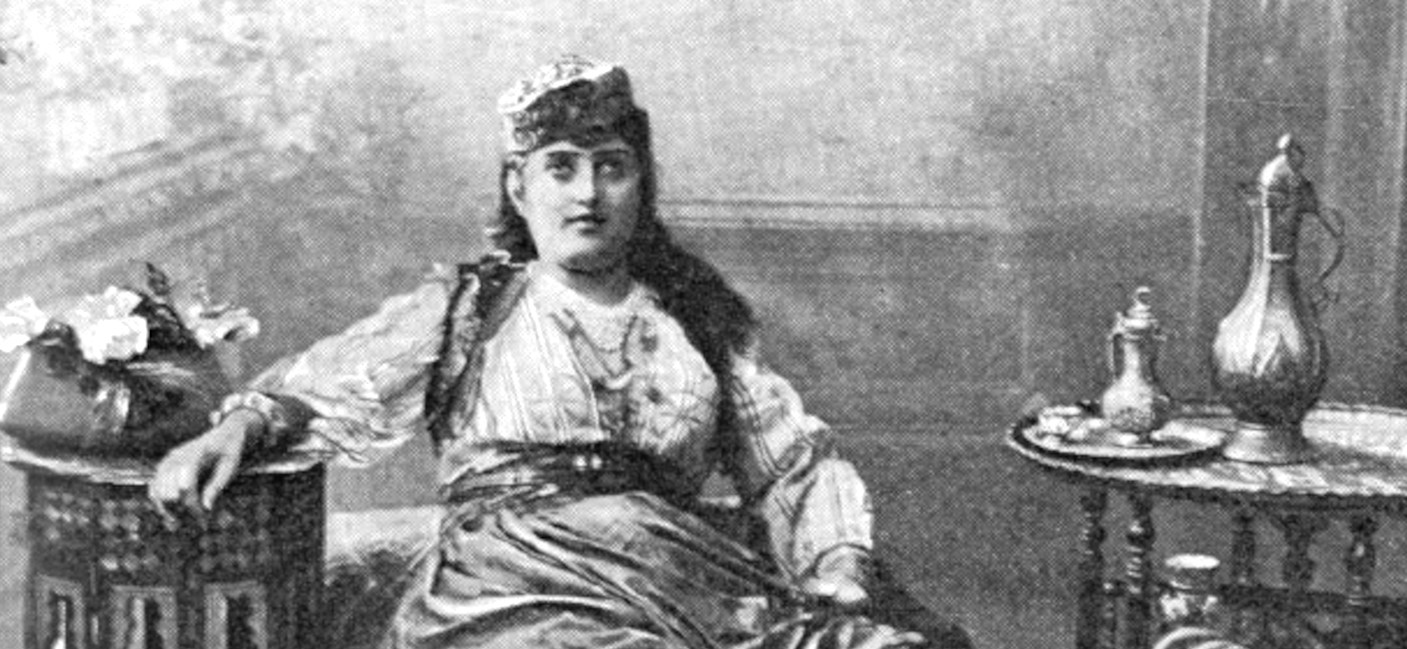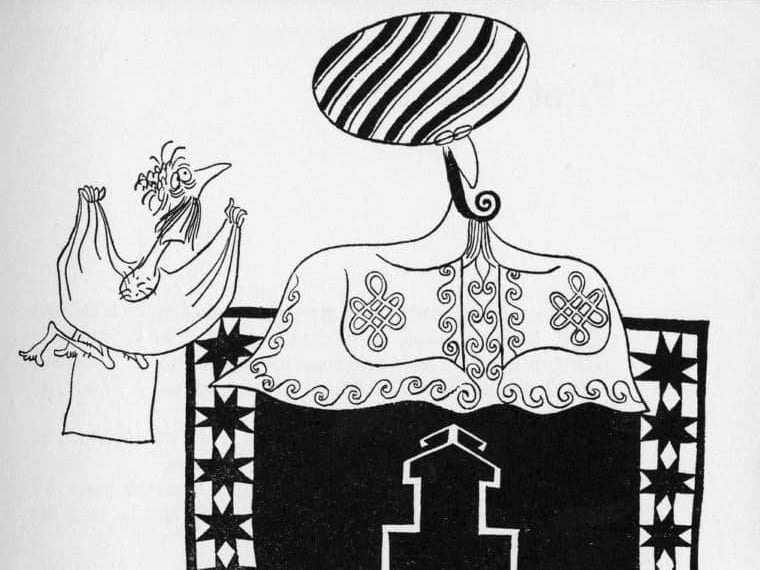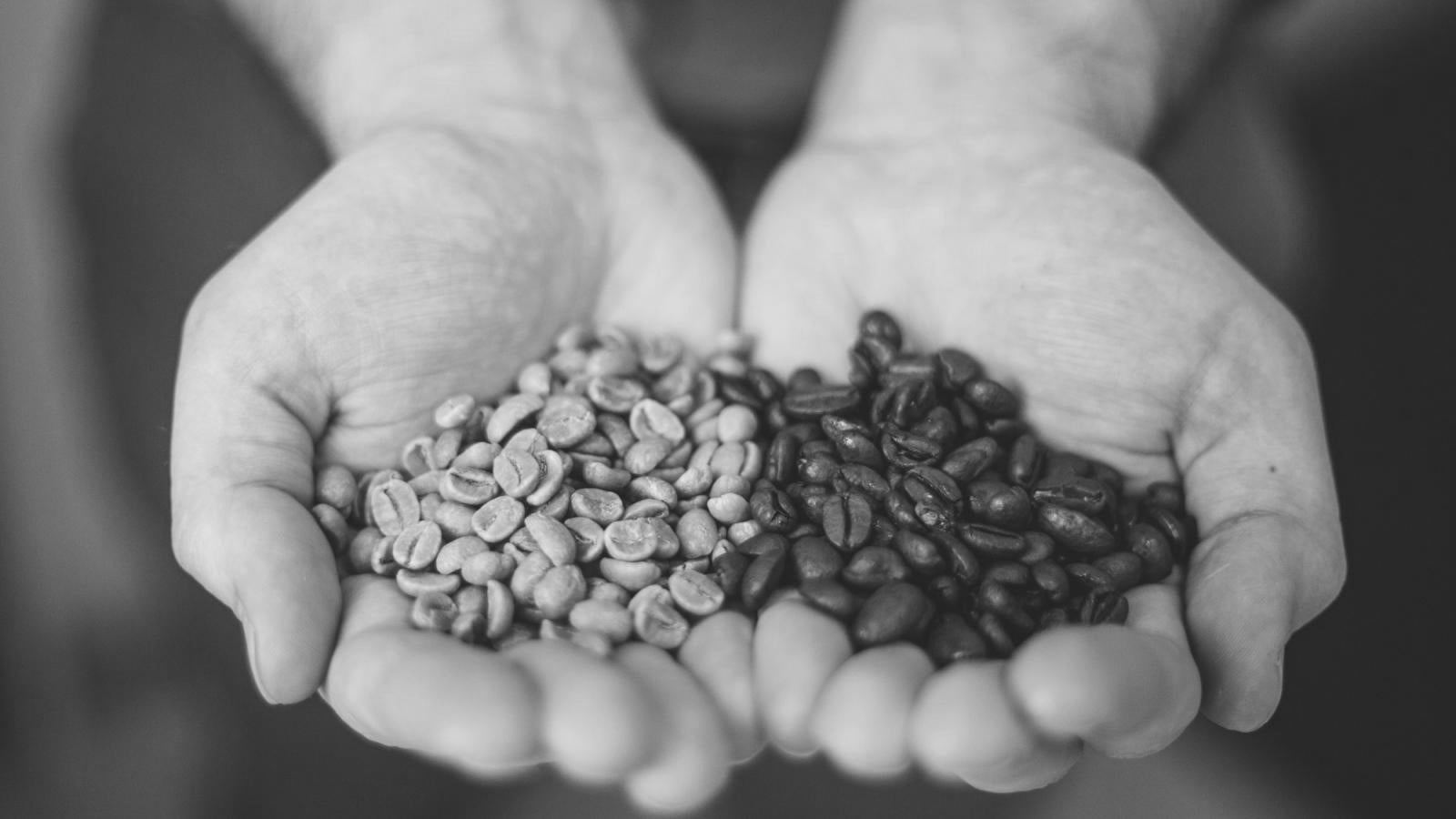Discover Indian coffee history and culture, Bean to brew, the aromatic journey of Indian coffee. Countless coffee estates are situated amidst the Western Ghats, a heavily forested area, the home of India’s coffee. Karnataka is the largest producer of coffee in India, with over 70% of the country’s production grown here.
In this Article
History: Baba Budanagiri, the birthplace of coffee in India
Chickmagalur (also called Chikkamagaluru or Chikmagalore), famous for its undulating hills, lush greenery and tranquil surroundings, is filled with coffee plantations throughout its length and breadth – it is the birthplace of India’s coffee and where the aromatic journey of Indian coffee starts.
The legacy of Baba Budan
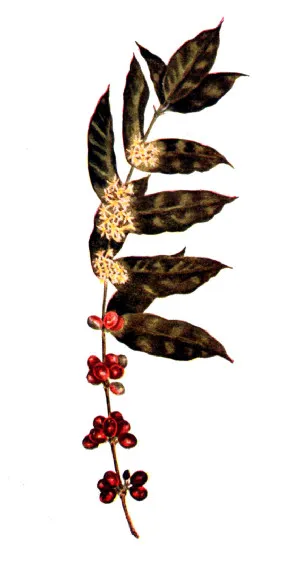
The legendary Sufi Baba Budan is said to have smuggled alive coffee beans from Mocha to India when he returned from his Hadj, pilgrimage to Mecca. He broke the Arab coffee monopoly smuggling seven coffee beans to India. Once home, he planted the beans in Mysore (today’s Karnataka) on the slopes of the Chandragiri.
These Hills are also known as Baba Budanagiri to remember the legacy of the Sufi. From these seven seeds blossomed what is India’s coffee industry and culture today.
Folklore suggests that Baba Budans smuggled coffee fruits were of the Arabica variety – or Mysore coffee, as it was once known. Coffea Arabica still grows here at higher elevations, and Coffea Canephora (Robusta) along the lower levels of the Baba Budan mountains. We visited the hills with our friend Avnish during Arabica harvesting season in order to gain a deeper understanding of the local coffee culture – enjoying every sip of coffee knowledge we could get.
As we left Chikkamagaluru town and began our ascent into higher climes, there were surprises at every hairpin bend: towering peaks, delightful valleys, meandering rivers, sparkling streams, water falls and the invigorating mountain air.
Set against a smooth hilly backdrop, the Western Ghats are picturesque in the Malnad district. On a lower elevation, the Robusta is flowering and covered in white, as we gain height, colorful cherries from green, yellow and orange to crimson, adorn the trees, till the bumpy, winding road leads us to naked, freshly harvested Arabica plants.
The most beautiful plantations are sprawling across Chikkamagaluru, Kodagu, and Hassan. Chikkamagaluru has a perpetual fragrance of coffee lingering in the air. The scent of coffee is the aroma of home-brewed memories and emotions, a fragrance both evocative and personal. That can transport you to a sprawling coffee house or a cozy breakfast with loved ones.
The journey of the coffee bean to cup starts with the blooming of the sparkling coffee blossoms; their scent reminds us of jasmine. These become coffee berries that take about eight to ten months to mature and turn crimson.

Coffee beans are the pits of the red fruit of the coffee cherry – the seeds.
After the manual harvest, where only ripe fruits are picked, the coffee beans go through a laborious process to become ready for roasting. The fruity cherries are hand sorted, dried, washed and peeled. The transition from raw to fragrant puts the seeds through fiery temperatures of between 180° to 230° Celsius.
It’s in this process that the character of coffee emerges. Quality checks are undertaken at each stage of production (sorting, drying, washing and peeling) to ensure the best quality. The seeds are finally ready for grinding and brewing.
From Bean to Brew: The aromatic journey of the coffee cherries

Rows of coffee bushes covered with sparkling white blossoms greeted us, and the whole area was heavenly with their exquisite fragrance. Smelling the things we eat and drink enhances our ability to taste them.
This sense is responsible for about 80% of what we taste. Indeed, we detect the underlying flavor of something – whether it’s a coffee flower, the macerating fruits, the coffee grind or the fresh brew – with our noses rather than our mouths.
Without a sense of smell, coffee wouldn’t taste nearly as nuanced. Several scientific studies have demonstrated that the scent of coffee alone (which has no caffeine) is strong enough to stimulate our cognitive function. Even a quick whiff of coffee might make us feel ready to conquer the day ahead.
Caffeeichor – this word of my creation describes exactly what the scent of coffee is for me – the sublime scent, born of the ethereal liquid flowing in the veins of the gods – making them immortal (Greek ἰχώρ ikhṓr). Ichor is also Ambrosia, the “favourite food or drink” of the gods in ancient Greek and Roman mythology. Hindu scriptures mention the “Elixir of Life”, or “Nectar of Immortality”, described by the Sanskrit term Amrita (or Amrit, in Sikh tradition).
It was believed that even a small quantity of Amrit would bring immortality upon the person consuming it, this is first found in Rigveda. Amrita happened during the samudra manthan or churning of the ocean.
Amrita is also mentioned as a synonym with Soma, described as the “gods’ drink of immortality”. Additionally, Soma is associated with the moon in the late Rigveda and Middle Vedic period. Surya, the daughter of the Sun, is sometimes stated to be the wife of Soma.
There are hundreds of known names for the “elixir”, writes Adina Riposan-Taylor , found in various cultures and at different times in history, in the extensive sense comprising:
Amrit Ras (or Amrita, the Indian name for “immortality juice”), Maha Ras (“the great juice”), Soma Ras (“juice of Soma”), Haoma (the version of Soma in Zoroastrianism), Hum (the Middle Persian form of Soma and Haoma), the Philosopher’s Stone (legendary alchemical symbol), Cintamani (the equivalent of the Philosopher’s Stone in Buddhism and Hinduism), Aab-i-Hayat (Persian name for “water of life”), Aab-Haiwan, Dancing Water, Chasma-i-Kausar (“Fountain of Bounty,” which Muslims believe to be located in Paradise), Mansarover (Pool of Nectar, or “mind lake” – the holy lake at the foot of Mt. Kailash in Tibet, close to the source of the Ganges).
Other legends refer to the myths of Thoth and Hermes Trismegistus, both of whom in various tales are said to have drunk “the white drops” (liquid gold) and thus achieved immortality, as mentioned in one of the Nag Hammadi texts. In Chinese myth and lore, the Moon Goddess Chang’e 嫦娥 took the elixir of life and the moon rabbit is pounding it on the moon.
“A cup of freshly brewed coffee is one of life’s simple pleasures
– Caffeeichor –
my caffeinated elixir of life”
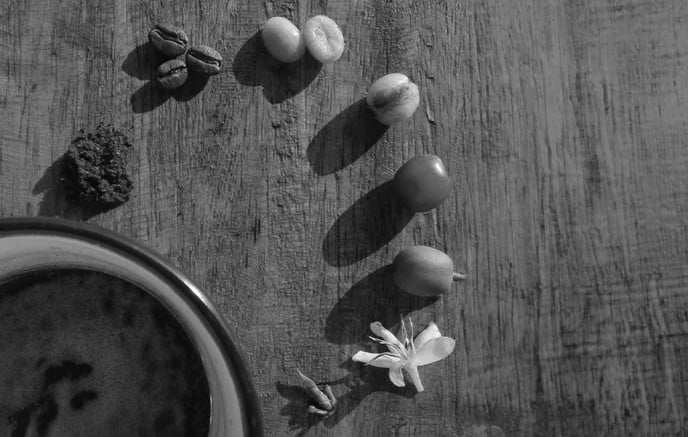
According to science, coffee is one of the most appetizing smells for humans. The coffee chemistry that gives coffee its distinctive aroma is still being decoded, with over 800 coffee components interacting with the olfactory epithelium and the brain. The unique aroma of coffee hits all the attractive scents, including sweet, spicy, fruity, floral, and smoky.
Specifically, each scent has its own molecule. Phenols create the bitterness found in coffee, but they also generate the smoky or earthy smell often found in dark roast coffee. Another molecule, Furfurylthiol, is known to be associated with “coffee smell”.
Additionally, Mercapto is a “spicy” scent commonly associated with curries and can even be found in human sweat. Lastly, Hydroxymethylfurfural (HMF) is responsible for the caramel or sweet smell. More molecules and aromatic compounds are listed here.
High-quality Indian coffee

Coffee isn’t indigenous to India, it comes from a plant belonging to the genus Coffea of the Rubisceae plant family originating from what is Ethiopia or Yemen today.
The intricate relationship between nature, craftsmanship, and the human senses in India gives birth to both Arabica (around 1/3 of India’s production) and Robusta (around 2/3 of India’s production) varieties of coffee.
Arabica coffee (Coffea Arabica L) is a small tree in its original habitat but grows like a shrub with bushy growth when trained. Arabica has a delicate flavor and balanced aroma, coupled with a sharp and sweet taste.
They have about half the amount of caffeine compared to Robustas. Arabica is susceptible to diseases like leaf rust and pests like the white stem borer. Arabicas are harvested from November to January and are typically grown on higher altitudes ranging from 600 to 2000 meters in cool, moisture-rich, and subtropical weather conditions with rainfall ranging from 1600 to 2500mm.
Coffee Arabica is a delicate creature that requires fertile soil, and coffee farmers meticulously nurture the plant preventing diseases, and managing shade and sunlight exposure.
Robusta (Coffea Canephora) is harvested between December and February at 500 to 1000 meters in hot and humid climates. Robusta is less fussy about its environment. It puts up better resistance to pests compared to Arabica. Today, Robusta accounts for 30% to 40% of the world’s coffee production.
Common Coffee Plant varieties of India:
Kents: Named after an English planter in the 1920s, Kents is an Arabica coffee known for its outstanding cup quality.
Cauvery: or Catimor, is a natural Bourbon mutant with exceptional cup quality.
S.795: This varietal was developed using Kents and released in the 1940s. It’s now one of the most popular Arabica coffees for planters to grow in India. It produces a balanced cup with subtle flavor notes of chocolate and caramel.
Selection 9: This varietal is a cross between two Ethiopian Arabica coffees and has won the “Fine Cup Award for Best Arabica” at an Indian cupping competition.
Sarchimor: Sarchimor is a hybrid of Timor and Villa Sarchi (from Costa Rica). It’s highly resistant to coffee leaf rust and stemborers.
Mysore: Mysore coffee can have more acidity than other coffees in the southern district of Nilgiris and Shevaroys.
Coffee Regions of India
The journey of coffee’s aroma is a sensory adventure, that spans the Western Ghats – Tamil Nadu, Kerala and Karnataka. Karnataka’s coffee plantations, take up more than 60% of the total area in India that’s used for cultivating coffee.
The Eastern Ghats – Andhra Pradesh, Telangana, and Orissa.
As well as the North East, with Assam, Manipur, Meghalaya, Mizoram, Tripura, Nagaland and Arunachal Pradesh, the new coffee growing regions of India.
(Map from Coffee Board of India)
Geographical Indication certification for Indian regional coffee
India’s coffee industry is diverse and vibrant. GI Tags (Geographical Indication certification) for Indian Coffee Varieties ensure that the community of producers is protected, and consumers receive the best quality. Monsooned Malabar Arabica Coffee and Monsooned Malabar Robusta Coffee have been registered in 2007.

Monsooned Malabar
Malabar was once the name for Arabica coffee. The monsoon season in India goes from June to August – and coffee producers around Mangalore take full advantage. Monsooned Malabar beans are processed differently than any other coffee in the world. The concept emerged back when coffee was regularly shipped from India to Europe in wooden vessels. The voyage would take up to six months, and by the time, they’d be transformed – much larger, paler, and uniquely flavored.
The “Monsooning” Process
By exposing top-grade coffee to monsoon rains and winds inside well-ventilated warehouses on India’s west coast, the seeds swell to about twice their original size. The color fades to pale gold or ghostly white during the 12 to 16-week process. The beans are then hand sorted to ensure consistency, re-graded, bagged, and moved to a drier region before being shipped to consumers.
The taste of Monsooned Malabar is unique: a creamy body with low acidity, hints of fruit and spice.
Coorg Arabica Coffee, Wayanad Robusta Coffee, Chikmagalur Arabica Coffee, Araku Valley Arabica Coffee and Bababudangiris Arabica Coffee got GI Tags in 2018. The animals on the coffee packaging stand for the coffee production area in their habitat.
Coffee growing areas of Bharat
Anamalais (Tamil Nadu)

Elephants are widely found in the Annamalais, a medium altitude (1000-1400 m) mountain range on the southern tip of the Western Ghats that experiences high rainfall. Coffee is grown with Pepper, Orange and Banana. The Arabicas here are finely grown large beans that are grayish green in color. The coffee from these beans tends to be more balanced with a strong aroma coupled with a citrus essence.
Bababudangiris (Karnataka)
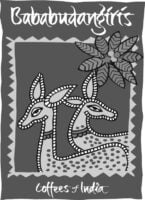
The region where the story of Indian coffee was born is named in honor of the legendary saint Baba Budan. With a peak altitude of 1500 meters, the region is frequented by spotted deer. The plantations here produce Pepper, Cardamom and Arecanut and full bodied Arabicas, which ripen at a relatively slower pace due to the mild weather conditions. The coffee from these carefully selected beans, which are processed through natural fermentation, has a full body, acidity, mild flavor and unmistakable aroma with a hint of chocolate.
Biligiris (Karnataka/Tamil Nadu)

The literal meaning of Biligiris is ‘white hills’, and these hills in south-eastern Karnataka get the name because their peaks are covered with silver clouds and white mist for most of the year, Sambar deer live here. They are among the highest altitude coffee growing regions in India, and the most famous variety coming from this region is the high elevation (1500m) S.795 Arabica. The coffee ripens slowly under a mild shade of silver oaks and fruit trees (Orange, Banana, Pepper), and has a full body, extremely sweet aroma and a uniquely mild flavor.
Brahmaputra (Seven sister states)
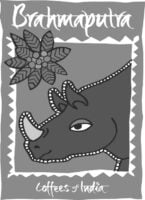
Coffee growing in the seven sister states of Northeast India – Assam, Manipur, Meghalaya, Mizoram, Tripura, Nagaland and Arunachal Pradesh – has been taken up in more recent history for uplifting the tribal communities in the region. The Brahmaputra river flows across these states, where it is common to find the mighty one-horned rhinoceros.Communities are growing Pineapple, Pepper, Jack fruit and Vegetables. Arabica is growing on 800-1200 m, and has a uniquely fruity essence, mild levels of acidity and a pleasant aroma.
Chikmagalur (Karnataka)
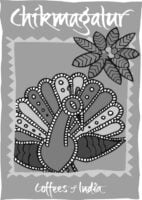
Chikmagalur also called Chikkamagaluru or Chikmagalore, in Karnataka is especially renowned for dense forests and wildlife sanctuaries (with an abundant presence of peacocks) apart from huge coffee plantations on 700-1200 m inter cropping Pepper, Cardamom, Areca nut, Orange and Vanilla.
It is home to the Central Coffee Research Institute and is also called the Coffee Country of India. The Arabica beans from this region have a medium body coupled with a light acidity and flavor, and medium to intense aroma.
Coorg (Karnataka)

Coorg, where huge swarms of honey bees are often found buzzing across plantations, is India’s largest coffee producing district. The region produces both Arabicas and Robustas on an altitude from 750-1100 m and also boasts high productivity. A lot of intercropping of coffee plantations is done with spices like Ginger and Pepper, Cardamom, Orange, Banana and Areca nut in Coorg.
While the Arabicas from Coorg are lightly acidic with a mild flavor and strong aroma, the Robustas are soft and neutral, with hues of chocolate.
Manjarabad (Karnataka)

Manjarabad is a relatively small geographical coffee growing area between Chickmagalur and Coorg, with medium elevation mountains and rainfall ranging from 1000-2500 mm. Inter cropping is done with Pepper, Cardamom, Orange, Areca nut and Banana.
The mixed shade Arabicas produced here are among the best, and planters in the region are known to be very innovative in deploying new technologies. These coffees have a medium to full body, mild acidity, medium to intense aroma and pleasant flavor.
Nilgiris (Tamil Nadu)

Nilgiris, or Blue Mountains, are situated on the Western Ghats and have elevations ranging from 900-1400 m. Besides its wildlife sanctuaries that host the spotted leopard, the region is known for high quality teas, Pepper, Orange, Banana, Ginger and Vegetables, as well as some of the best ‘Kents’ Arabica. The coffee beans are bold and bluish green in color, and ripen slowly in the mild climate. The beans produce coffee with full body, sharp acidity, striking aroma and mild flavor.
Pulneys (Tamil Nadu)

The Pulneys hill range is situated adjacent to the popular Kodaikanal hill resort, which is on the southernmost tip of the Western Ghats. Among the unique features of this hill range is the bluebell-like Kurinji flower that is visible only once in 12 years. Along wit Orange, Banana, Pepper, Cardamom and Vegetables some of the best Arabicas are grown here (600-2000 m) like S.795, S1n.10 and Cauvery. These coffees have medium body, medium plus acidity and a slight favor coupled with a citrus aroma.
Sheveroys (Tamil Nadu)

The Sheveroys region has large lakes and tall peaks, where premium Arabica coffees like S.795, S1n.9 and Cauvery are grown at altitudes of up to 5000 feet ( 900-1500 m) under silver oaks. These plants are commonly farmed with orange trees and pepper vines.
The berries mature at a slow rate and acquire a bluish green color. They produce coffee with a medium body, good acidity and slight flavor with a tinge of spice. The lower areas of the hills in the region are frequented by the Gaur or Indian bison.
Travancore (Kerala)
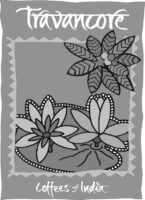
Travancore is an erstwhile princely state in southern Kerala, where lotus flowers are often found growing in shallow waters. Two separate coffee growing areas are part of the region – Idduki (mostly Robusta) and Nelliampathys (both Arabica and Robusta 400-1600 m). The mountains of Idduki are of medium to high elevation, and are also home to numerous plantation crops, spices and medicinal plants. Nelliampathys, on the other hand, is well known for Robustas (CxR ) with a full body and sweet taste and very little bitterness.
Araku valley (Andhra Pradesh)

The Araku Valley situated in the Eastern Ghats of northern Andhra Pradesh and southern Orissa is inundated with a vibrant and colorful population of parrots. The development of coffee plantations here is more recent, and has been a boon to the tribal populations here, since it has provided them with a viable alternative to their traditional methods of shifting cultivation. Coffee is grown with Pepper, Mango, Jack fruit and Vegetables. This region on an elevation of 900-1100 m produces coffee with medium body, medium to sharp acidity and intense aroma with spicy notes.
Wayanaad (Kerala)

Wayanaad in northern Kerala is popular as the home of the Indian tiger. In addition, it is the largest Robusta producing region in India with its medium altitude hills of 600-900 m, characterized by their gentle slopes and rich laterite soil. A wide variety of plantation crops (Pepper, Banana, Ginger, Vegetables) are grown in the small coffee plantations in this region, including spices and condiments as well as staple foods like yam. The CxR and S.274 Robusta varieties from Wayanaad are most popular with their softish to neutral essence, full body and strong aroma with hints of chocolate.

The truth is and why hide it — most coffee growers in India do not drink coffee.
Arshiya Bose
Farming: Making flavor blossom from the coffee beans

Indian coffee is produced in different geographies, under varying degrees of rainfall, ranging from 800 mm to 4500 mm, and altitudes of 600 m at Wayanaad, to 2000 m at Pulleys. These variations bring subtle but delicious variations to the flavor of Indian coffee.

Each cup we savor is a testament to the artistry of nature and the expertise of those who cultivate and harvest the beans, quality coffee has its origins in the heart of the coffee plantations of the Malnad region in Karnataka. These estates are the cradle of Indian coffee. Home to a community of farmers, families, and workers who help bring delicious coffee to our table.
Coffee-growing is a science, taking into account soil quality, moisture content, monitoring sugar levels, and using the latest technology.

The ecologically sensitive regions of the Western and Eastern Ghats are a biodiversity hot spot of the world. Coffee contributes significantly to sustain the unique diversity of the region and is also responsible for the socio-economic development of the remote, hilly areas. The Ghats, an UNESCO World Heritage Site , make the perfect environment for coffee, with the altitude, rainfall, and temperature all contributing to the plant’s growth and flavor.
Regenerative farming practices have become increasingly popular among coffee farmers around Chikmagalur. These practices focus on improving soil health and biodiversity, reducing chemical inputs, and creating a more sustainable and resilient farming system.
We enjoyed the dazzling variety of wildlife and the bird watching around the coffee estates
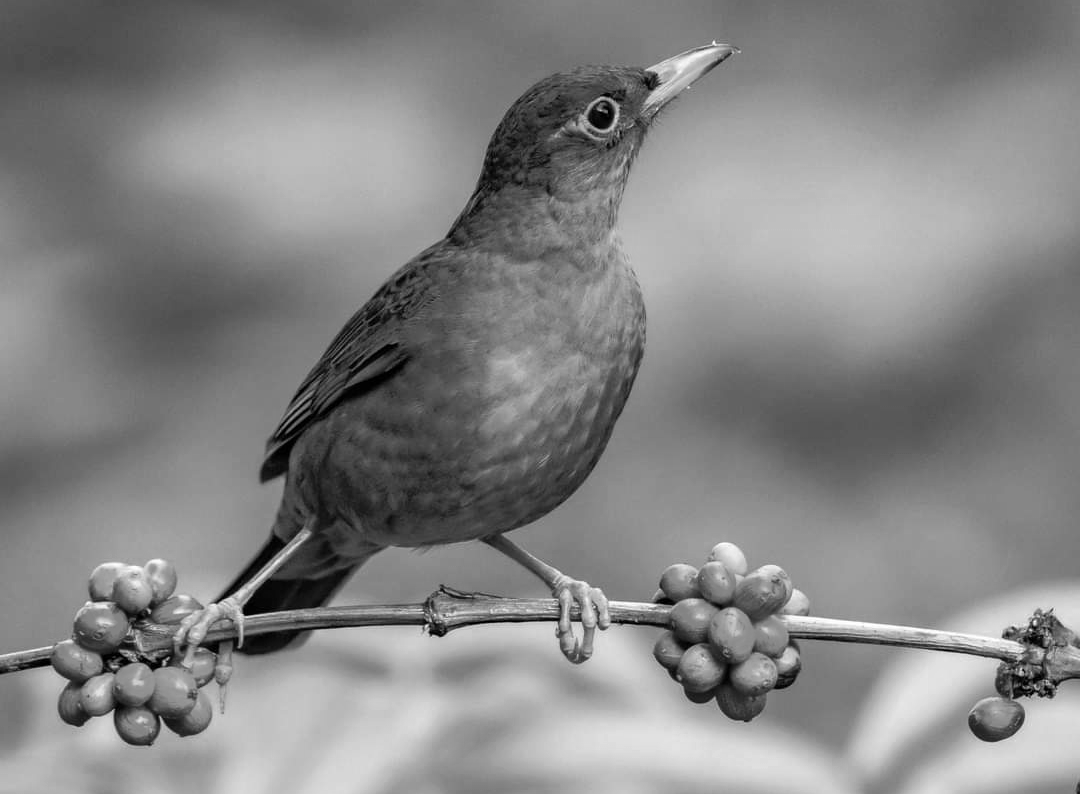
It is a serene environment, as the melodies of the birds soothe the ears. The diverse and stunning landscapes are home to a dazzling variety of local and migratory bird life.
The plantations are home to colorful birds of every description and color: Blackbirds, Minivets, Woodpeckers, Bee Eaters, King Fishers, Drongos, Malabar Grey Hornbills, Sunbirds, Golden Orioles, Barbets, Mynas, Wagtails, Magpie Robins, Swallows, Spotted Doves, Rose Ringed Parakeets, Rufous Tree Pies and Eagles. Bats, rabbits, civet cats, deer, common langurs, ratsnakes, bonnet macaques and the Malabar giant squirrels are easy to spot in animal friendly coffee estates.
Also iconic mammals, like the Bengal tigers, the Indian leopards, the majestic Asian elephants and the stately bisons frequent them.

According to the Coffee Board, India is the only country growing 100% of its coffee under shade trees , producing a low-acid, mild, full-bodied, and exotic-tasting brew – with hints of cardamom, pepper, clove, nutmeg, and even tropical fruit. Coffee plants naturally grow in the shade, and on traditional coffee farms, shade trees (wild fig trees) are used to protect the coffee plants from direct sunlight.
As sunlight is required for optimal growth, one third of the shade cover is cut each year, to create a 50-60 per cent ratio of shade and sunlight. Rich biodiversity is prevalent under the canopy of trees, contributing to a healthy ecosystem. Trees provide habitat for migrating birds and other wildlife, which in turn helps control pests and diseases.
In addition, the fallen leaves of the shade trees act as a natural fertilizer, reducing the need for chemical inputs.
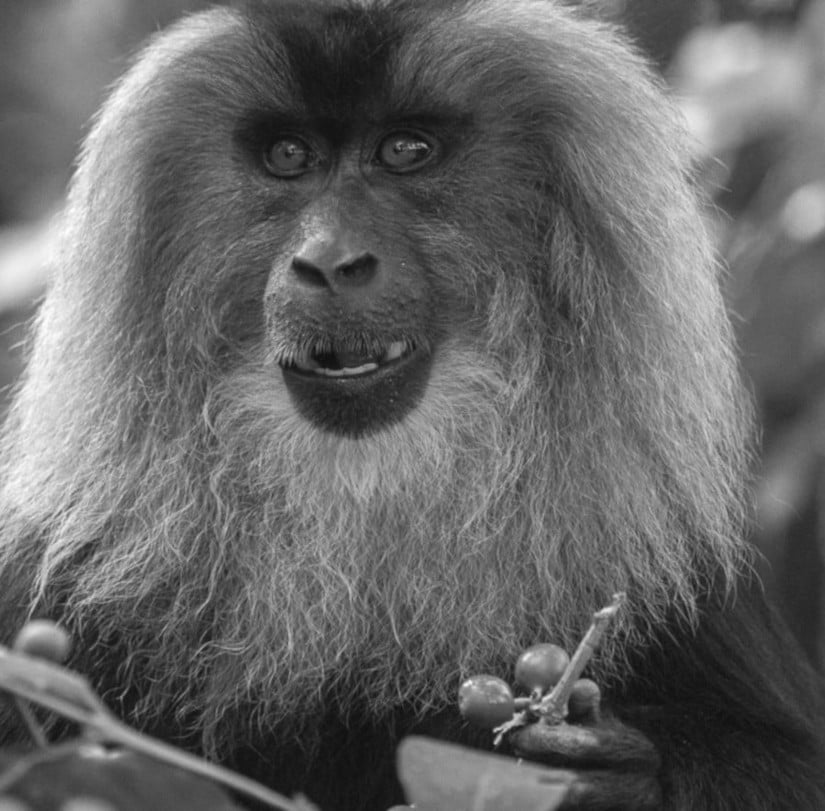
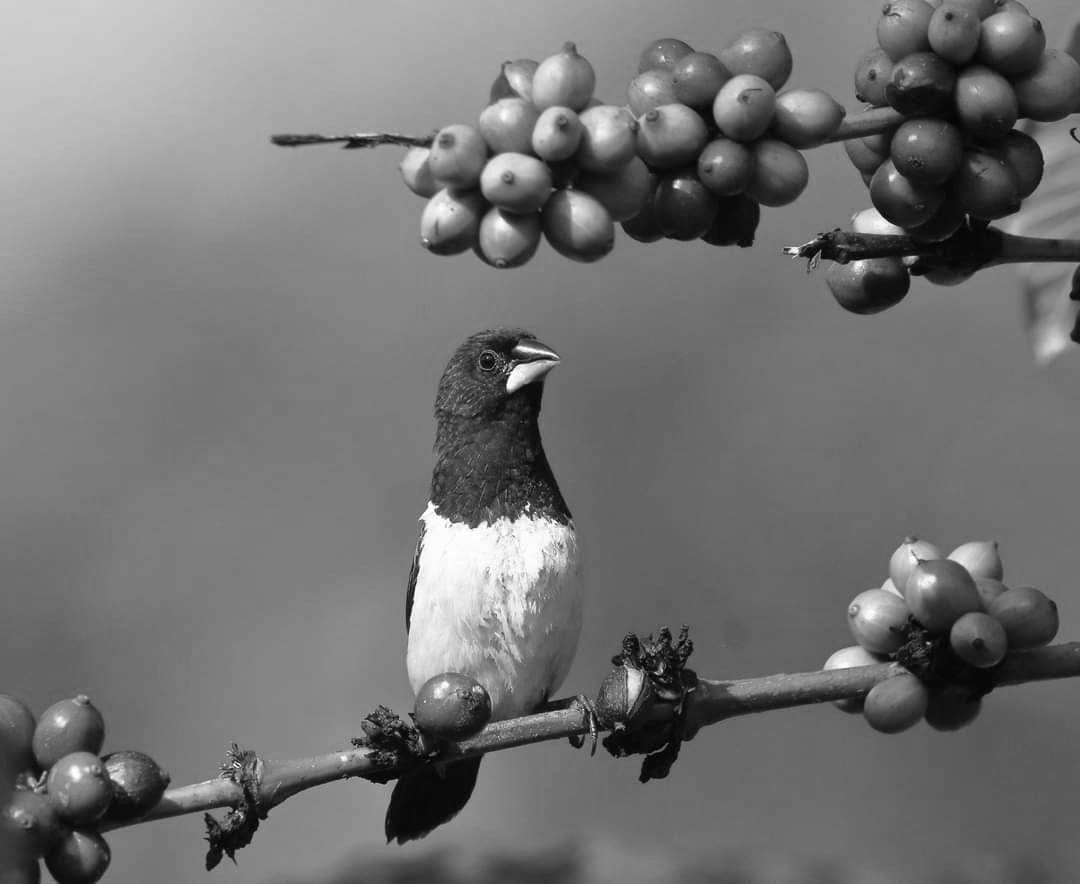
Inter cropping involves growing multiple crops together in the same field, which also helps improve soil health and biodiversity. Other than Arabica and Robusta, they grow silver oaks in abundance. Jackfruit, pepper vines, wild figs, Indian gooseberry, bird’s eye chili, turmeric, ginger, all-year mangoes, and citrons grow wildly.
Farmers in Karnataka have been intercropping coffee with a range of crops, including spices like cardamom, as well as fruits like banana and orange. Also, rubber trees, areca nut palms, coconut palms, cashew trees, and tea grow amid the lush greenery.
By leaving uncultivated sectors of natural “weeds”, excellent populations of pollinators like spiders, butterflies, bees, wasps, dragonflies, frogs and lizards thrive.
A few of India’s coffee estates still belong to local families who are trying to uphold their heritage. The majority is controlled by giant multinationals.

Selecting the Coffee cherries

Indian coffee is mostly handpicked and then sun-dried.
The fruits of the coffee plant undergo careful harvesting to ensure the highest quality.
There are two primary methods used in Bharat:
- selective picking (handpicking only the ripe cherries) and
- strip picking (harvesting all the cherries from a branch at once).
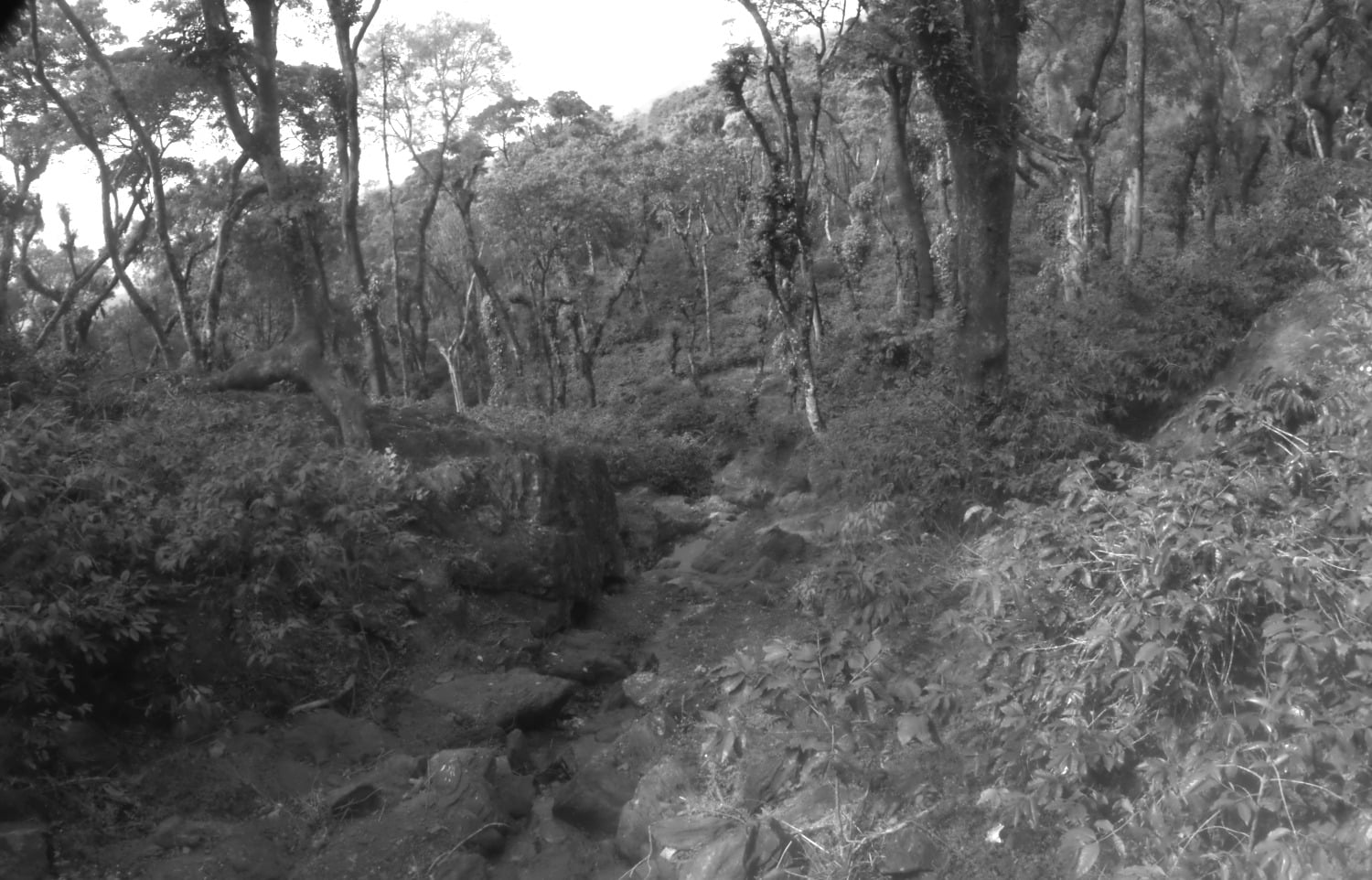
The flavors of the fruit
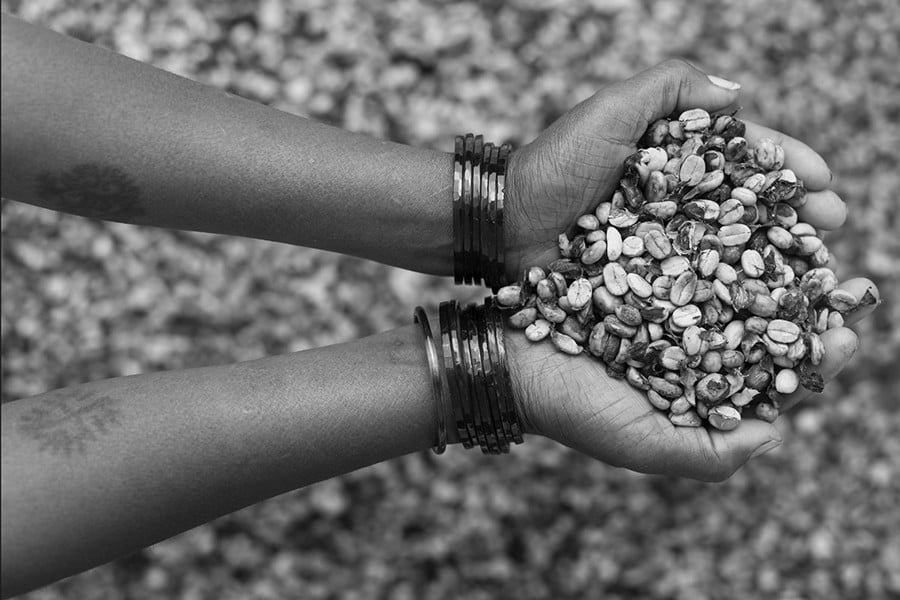
Separating the coffee seeds from the fruit cask :
Washed Process: This method involves removing the outer skin and pulp from the cherries using water and fermentation. It results in clean, bright beans with a vibrant acidity.
Natural Process: In this method, the cherries are dried with their fruit intact. The sun’s heat and airflow transform the cherries into dried, raisin-like fruits. Natural processing brings out fruity and wine-like flavors, along with a full body.
Honey Process: This process lies between the washed and natural methods. The cherries are partially washed, leaving some of the fruit pulp intact during the drying process. It leads to beans with a unique sweetness and complexity.
Roasting Magic
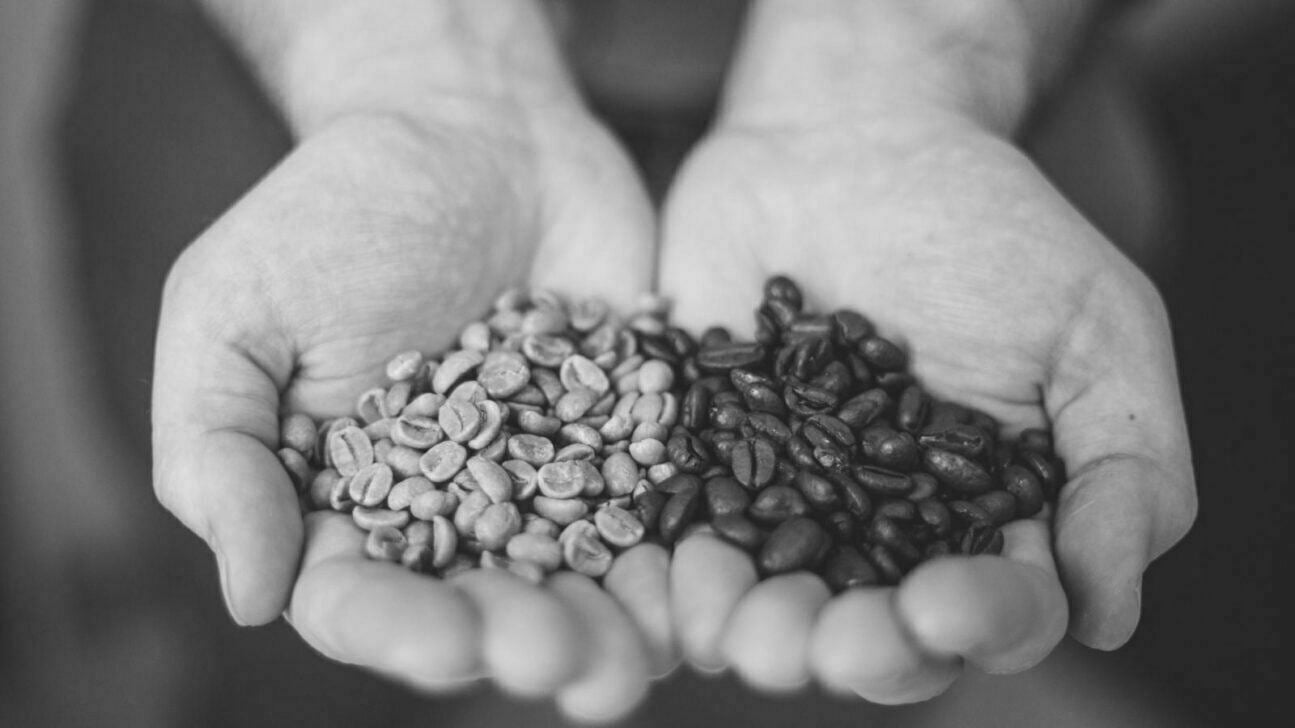
The Hulling is the last step, the silver skin and parchment covering the green beans is separated. Later the single coffee bean is graded and sorted. The green beans can retain the flavor and freshness for up to 12 months if stored well.
The roasting process is where the seeds develop their distinct flavors and aromas. As the beans dance in the roaster, their scent evolves from grassy to toasty, with hints of nuttiness and spice.
The aromas of caramelization and bitter sweetness fill the air, announcing the transition from raw to fragrant. It’s in this process that the character of coffee emerges.
Grinding the coffee beans

Transforming coffee beans into a fragrant powder is a pivotal moment that sets the stage for the aromatic symphony. The release of essential oils from the freshly ground seeds fills the air with a potent and irresistible aroma.
Grinding coffee increases its aroma by increasing the surface area of the coffee to release more aromatic compounds.
Coffee must be freshly ground: after only 15 minutes the product loses 65% of its aromatic profile.
Brewing Rituals
Each step of the brewing process releases a symphony of aromas, captivating our senses and building anticipation for that first invigorating sip. Brewing coffee produces even more aroma.
That’s why a cup of coffee may not smell the same as the ground coffee produced. The brewing process, whether it’s through decoction methods (boiled coffee, Turkish coffee, percolator coffee and vacuum coffee), infusion methods ( Indian drip filter coffee and Napoletana), and the Italian pressure methods (Moka and espresso), infuses the air with an aroma that tantalizingly teases the senses.
The brewing technique also determines the time the coffee is in contact with water, accordingly certain coffee roast styles are more suitable for certain brewing techniques.
Iconic Indian filter Kaapi
Without a filter Kaapi, coffee in the morning is like without the sun in the sky.

South Indian filter coffee comes in many forms and is known by various names, Decoction coffee, Kaapi, Mylapore Filter Coffee, Madras, Kaapi and Kumbakonam Coffee. The town of Kumbakonam in Thanjavur district Tamil Nadu, typifies the culture and ethos of the people of the district and hence the filter coffee has acquired the name of “Kumbakonam Degree Coffee” aka “Kumbakonam Filter Coffee”.
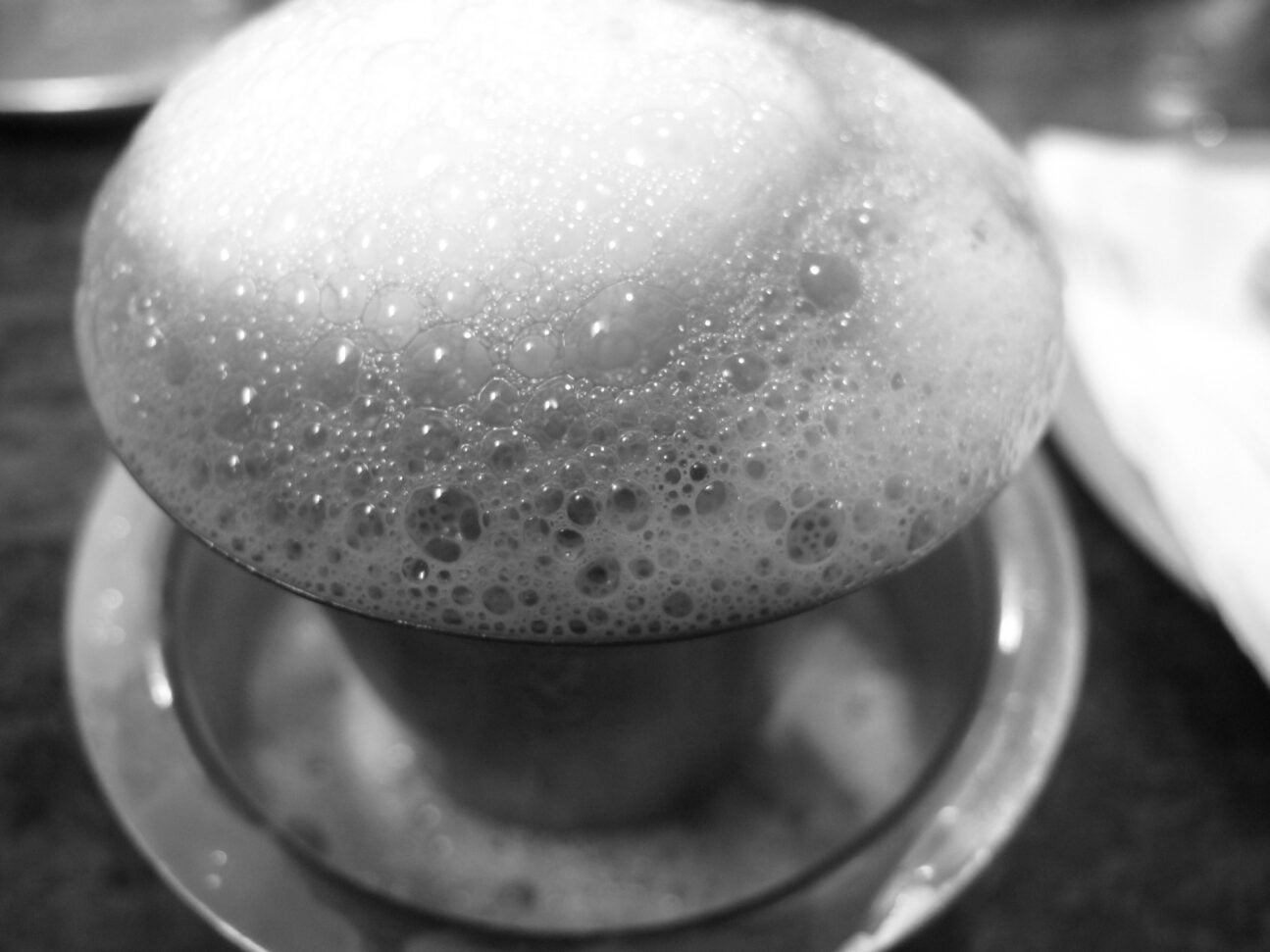
Prepared in a traditional Indian filter pot, Indian coffee decoction is brewed delicately by allowing boiling water to seep through finely ground coffee (with or without chicory), aided by gravity, – and the pressure built by steam inside the covered top chamber.
The brewing is not fast, but excruciatingly slow, as the coffee drips idly to form the ‘decoction’. The strong concoction is poured into a metal cup, known as a davara, which is served inside a stainless-steel tumbler.
Filter kaapi – scorching, strong, sweet and topped with a bubbly froth

An anecdote related to the distance between the pouring and receiving cup leads to the name, “Meter Coffee” for the drink. The unique serving style adds to the overall experience of enjoying a cup of Kaapi.
The complex symphony of aromas intensifies, with each note revealing a layer of the coffee’s character. The steam rising from the milk-less cup carries with it a medley of scents – nutty, chocolaty, fruity, or floral – each one a reflection of the beans’ origin, roast, and preparation.
The creamy, frothy top layer coats your tongue, enveloping you and making you feel cozy to the last drop.
Kaapi is not just a beverage, but holds a full davara (cup) of cultural significance. It has been a part of South Indian households for generations and is deeply ingrained in the daily routine and lifestyle of the people. It is shared as a sign of hospitality and is considered an essential part of social gatherings and festivals. It symbolizes the age-old Indian tradition of treating guests as gods, signifying that their presence is valued and respected.
Modern Indian café culture has introduced coffee to many, and even in traditional coffee-drinking regions it has brought more variety to the cup. Baristas serve Italian espresso, cappuccino, filter or decoction coffee to people who had fewer options before.
Coffee drinkers are getting more aware of quality, tastes and flavors and the value of Indian coffee.
Sip, savor, socialize: History of Coffee and Coffeehouses in India
India’s coffee culture dates back to the sixteenth century, when the first seeds arrived with Arab merchants, likely originating in what is now Ethiopia (or perhaps Yemen), where legendary goats were particularly frisky after eating the berries. The mythical origins of coffee are steeped in legend and topped with a creamy dollop of speculation.
From the Arabian Peninsula, there is mention of roasting and brewing coffee in the 15th century. Later, it was believed that coffee was used by Sufi saints to keep themselves awake during their religious rituals.
Tales of wild coffee in the Western Ghats before plantations were established exist – was it the coffee plants in the Baba Budan range that thrived unattended and continued to grow wild? By the 16th century, coffee drinking had spread to the rest of the Middle East, Persia, Turkey, North Africa and to Mughal India.
By the 17th century, coffee had become an important part of everyday life in the Mughal cities. It was served in public spaces called qahwahkhanas (coffee houses), and there were many around Delhi’s Red Fort, especially in the Chandni Chowk area. In her essay Spilling the Beans: The Islamic History of Coffee, food historian Neha Vermani describes, that the Arab ki sarai, an inn run by Arab traders, was famous for preparing sticky, sweet coffee, in 18th-century Mughal Delhi.
As the East India Company slowly spread across hill stations and the rest of India, coffee, pepper and tea plantations, and coffee houses went alongside. The earliest coffee plantations in Chickmagalur and Coorg were established in the late 19th century.
Coffee houses or clubs, came up – first in Calcutta in 1780, only to serve the British.
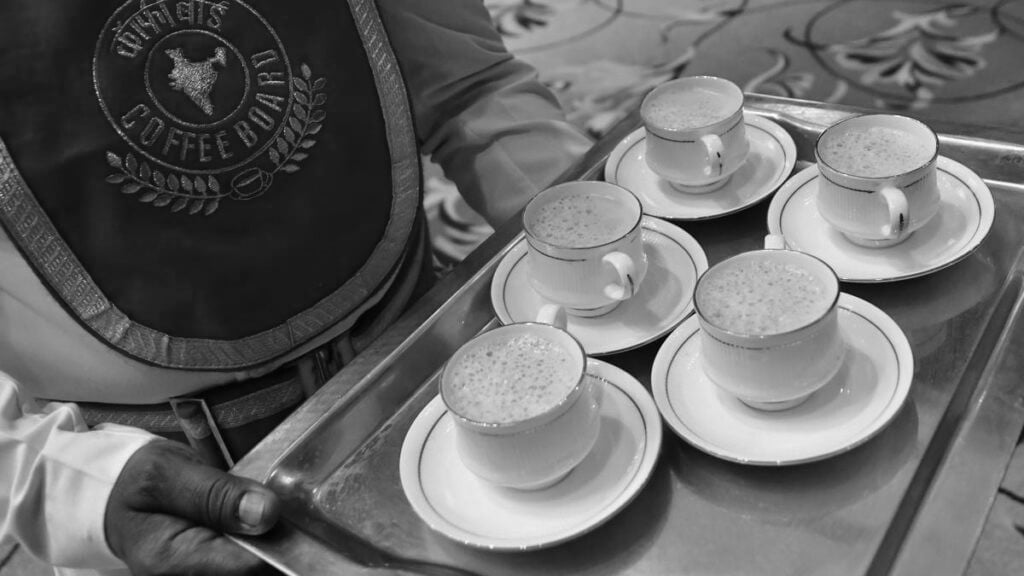
The Indian Coffee House was opened by the Coffee Cess Committee in Churchgate (later Coffee Board of India), Bombay [Mumbai], in 1936, and then, across the country more coffee houses were opened.
With the aim to provide a place for the country’s elite to meet and educate about the benefits of homegrown coffee. Although successful for many years, the a government-controlled Coffee Board’s policy changed in the mid-1950s and closed down all of their outlets.
The Indian Coffee Board mainly focuses its activities in the areas of research, extension, development, market intelligence, external & internal promotion for coffee since.

CC0
Communist leader A. K. Gopalan, encouraged coffeehouse workers to start a cooperative and take over the business from the Coffee Board. In 1957, the brand was established as a worker cooperative and renamed the Indian Coffee House (ICH). Its first outlets opened in Bangalore and New Delhi.
Today, there are over 400 Indian Coffee House outlets across the country, managed by 13 cooperative societies. Since then, every worker at the Indian coffee House is a co-owner.
We stopped by Siri Coffee, a coffee house at Siri Nature Roost. There is a sculpture of a Devi (godess) draped in greenery and decked with plants and flowers. The aesthetically carved statue of the Vanadevathe is Chikkamagaluru personified – she is nature, she gives all she has to you, all she asks in return is to keep her clean, green and ever flourishing. Vanadevathe is there, to speak the proud history of Chikkamagaluru.


Visiting Chikkamagalore and Baba Budanagiri, we have often been sharing a coffee, by friendly and curious locals. Clicking the tongue in appreciation for the kaapi, with an occasional ‘Uhh…Waah…!’ and whirling the glass quickly, before the last sip.
Having a coffee means sharing stories and being part of a deeply cultural ritual from bean to brew. Avnish and us, drunk in the centuries-long history of Kaapi, so much of it, that – one evening – I couldn’t find sleep – so caffeinated I was!
We brew some intriguing tales with the communities we visited at the estates, farms and home stays, chatting with owners and labourers – Learning from the people at the coffee board, the Central Coffee Research Institute (CCRI), Coffee Yatra Museum in Chikmagalur, at Coffee Curing Works, the stalls, darshinis, and small coffee establishments at the market or the coffee lorry drivers at loading stations around Chikkamagalore and in Baba Budanagiri. All of them cultivating a love of coffee, hard work, and kindness.
These pride coffee communities not only want to understand the fruit and business, but themselves too. Amidst the variety and confusion there is a deeply felt sense of belonging which we heard in all the stories that were told to us. Chikkamagaluru is like it’s Kaapi – rich and full-bodied – beneath the surface of the foaming hot milk, a substance that keeps your heart beat – memories as fragrant and fresh as ever.
Thank you woman and man carrying on coffee heritage, for the rich and aromatic flavors of Indian coffee. ♨

~ ○ ~
Keep exploring:
Works Cited & Multimedia Sources
The history of coffee is an extraordinary study. If you would like to learn more about it, we heartily recommend the book, All About Coffee, by William Ukers. Written in 1928, it is as good a book on coffee as has been written and will delight you with detail.
Also the new book Short History of Coffee, by Kerr Gordon is delightful.
Thank you Klaus Langrock for proof reading.
- Elliot R.H.The Experiences Of A Planter In The Jungles Of Mysore.
- Hakala Walter N. A Sultan in the Realm of Passion: Coffee in Eighteenth-Century Delhi. Eighteenth-Century Studies. 2014.
- https://www.middleeasteye.net/discover/india-coffee-lost-culture-mughal-empire
- http://www.teacoffeespiceofindia.com/coffee/coffee-origin
- https://bearessentialscoffee.co.uk/2020/05/29/coffee-tales-part-2-baba-budan-and-the-seven-seeds/
- https://blog.lovers.coffee/indian-coffee-indias-transition-from-tea-to-coffee/
- https://chikmagalurtourism.org.in/baba-budangiri-datta-peeta-chikmagalur
- https://digitalgems.nus.edu.sg/shared/colls/hisher/files/VoyMan.pdf
- https://economictimes.indiatimes.com/how-can-filter-coffee-be-so-different-yet-good/articleshow/22762503.cms?from=mdr
- https://en.wikipedia.org/wiki/Baba_Budan
- https://en.wikipedia.org/wiki/Baba_Budangiri
- https://food52.com/blog/25751-what-is-south-indian-filter-coffee
- https://isabelwrites.files.wordpress.com/2012/02/south-india-coffee-trail-in-silkwinds-oct-2015.pdf
- https://mediaindia.eu/freestyle/coffees-humble-roots-in-india/
- https://tattvamasiorganica.com
- https://theprint.in/india/datta-peetha-bababudangiri-how-karnatakas-hindu-muslim-shrine-became-ayodhya-of-the-south/786719/
- https://timesofindia.indiatimes.com/blogs/symphony-of-tastes/poetic-rendition-of-indian-coffee-house-alleppey-india-in-sonnet-style/
- https://web.archive.org/web/20160917181332/http://www.teacoffeespiceofindia.com/coffee/india-coffees-varieties
- https://whc.unesco.org/en/list/1342
- https://worldcoffeeresearch.org/focus-countries/india
- https://www.cntraveller.in/story/when-indian-coffee-house-was-the-countrys-living-room
- https://www.coffees.gr/baba-budan-story/?sl=en&s_layout=13
- https://www.deccanherald.com/india/karnataka/chroniclers-coffee-bean-2104866
- https://www.deccanherald.com/india/karnataka/chroniclers-coffee-bean-2104866
- https://www.firstpost.com/art-and-culture/a-short-history-of-the-india-coffee-house-conversation-revolutionary-politics-and-a-different-way-to-do-business-9184321.html
- https://www.folger.edu/blogs/shakespeare-and-beyond/islamic-history-of-coffee/
- https://www.kaapi.com.au/indian-filter-coffee
- https://www.madrasmusings.com/vol-31-no-1/coffee-and-the-city/
- https://www.masalakorb.com/south-indian-filter-coffee-filter-kaapi/
- https://www.masalakorb.com/south-indian-filter-coffee-filter-kaapi/
- https://www.middleeasteye.net/discover/india-coffee-lost-culture-mughal-empire
- https://www.researchgate.net/publication/360227425_ORIGIN_OF_COFFEE_IN_INDIA_A_MAJOR_INDUSTRY
- https://www.slowfood.com/the-story-of-coffee-in-india/
- https://www.thesouthindiancoffeehouse.com/gallery/
- Jonathan Morris. Coffee: A Global History. 2019.
- Lee Allen, Stewart. The Devil’s Cup: Coffee, the Driving Force in History, Soho. 1999.
- Mennell Stephen. All Manners of Food. Eating and Taste in England and France from the Middle Ages to the Present. 1995.
- Nagegowda Dr H.L. Bettadinda Battalige – Coffeeya kathe (Story of Coffee).
- Nirmala Lakshman, Degree Coffee by the Yard. 2013.
- R.K.Narayan’s. My Dateless Diary. 1960.
- Saasubilli Paradesi Naidu. Coffee Industry in India – A Historical Perspective. Journal
- Of Humanities And Social Science. 2018. https://iosrjournals.org/iosr-jhss/papers/Vol.%2023%20Issue8/Version-4/D2308042933.pdf
- Stephen Blake. Shahjhanabad: The Sovereign City in Mughal India, 1639–1739. 1991.
- Thakur Sankarshan. The Brothers Bihari Paperback. 2015.
- The Experiences Of A Planter In The Jungles Of Mysore
- The Voyages and Travels of J. Albert de Mandelslo. 1638. https://archive.org/stream/in.ernet.dli.2015.531053/2015.531053.mandelslos-travels_djvu.txt
- Vermani Neha. Spilling the Beans: The Islamic History of Coffee. https://themuslimtimes.info/2023/05/31/spilling-the-beans-the-islamic-history-of-coffee/
- Wild Antony. Coffee: A Dark History. 2005.

